
Section F Roman, Muslim, and Crusader Periods
Chapter 67 - Muslim Temple Mount: Al-Haram al-Sharif, or “The Nobel Sanctuary” (Muslim)
The Temple Mount is known in Jewish tradition as “Beth Yahweh” or “House of Yahweh” – God’s dwelling place on earth. Jews, Christians and Muslims traditionally believe that Solomon built his temple on the Temple Mount, and according to tradition (not scripture) that Adam is buried on the Temple Mount.
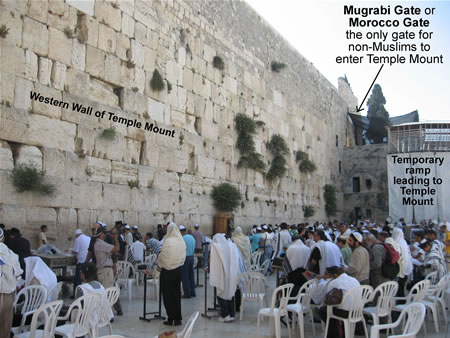
In 2007, after a landslide two years before made the earthen ramp leading to the Mugrabi Gate unsafe and in danger of collapse, the Israel Antiquities Authority started work on the construction of a temporary wooden pedestrian pathway to the Temple Mount. The ramp to the Mugrabi Gate (Morocco Gate) is to the right in this photo. Before the Jews excavated the Western Wall and removed the dirt built up over time, the gate was at ground level.
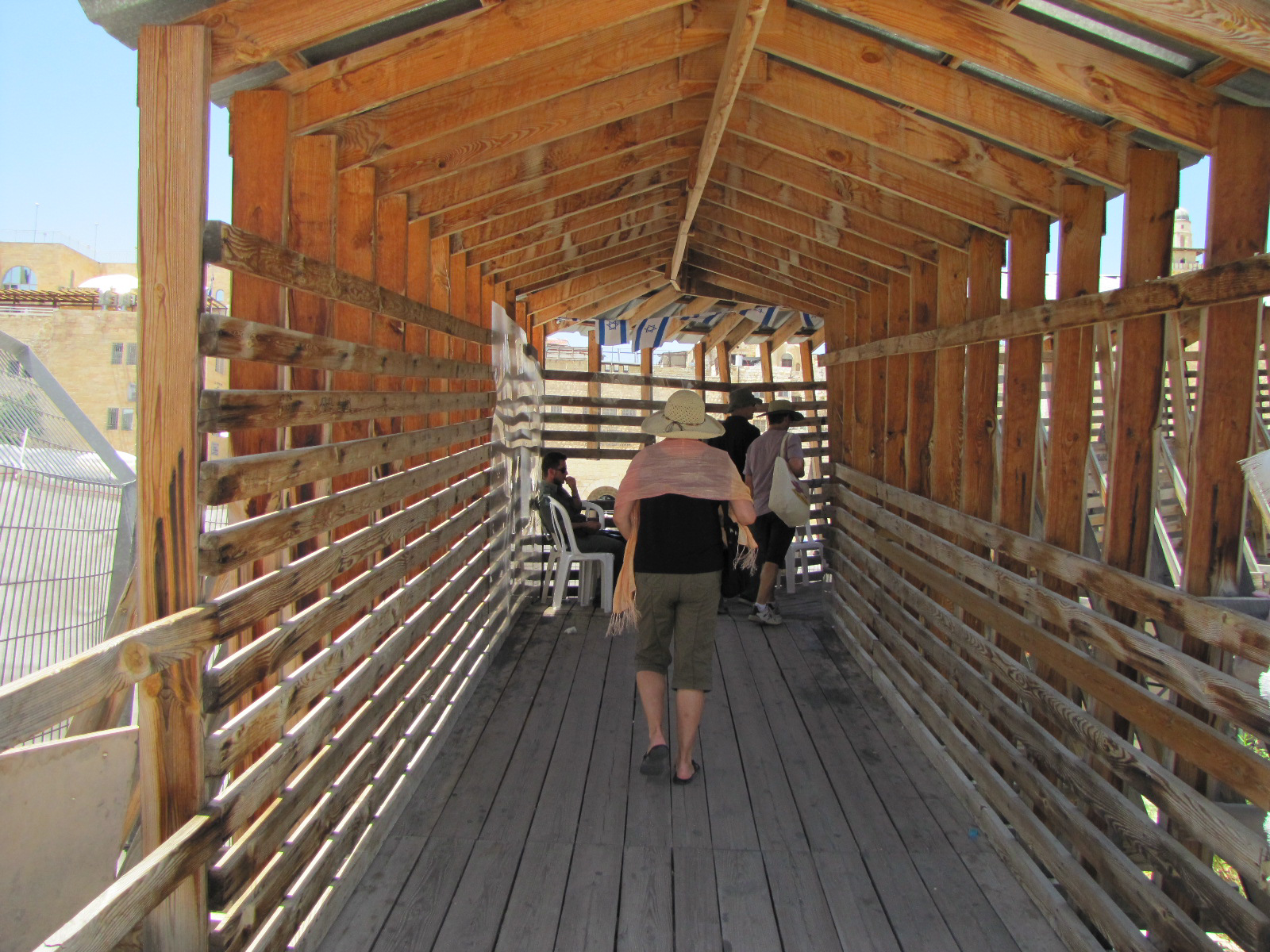
Toni ascends the wooden ramp over the Western Wall up to the Morocco Gate, which is the only entrance to the Temple Mount for non-Muslims.
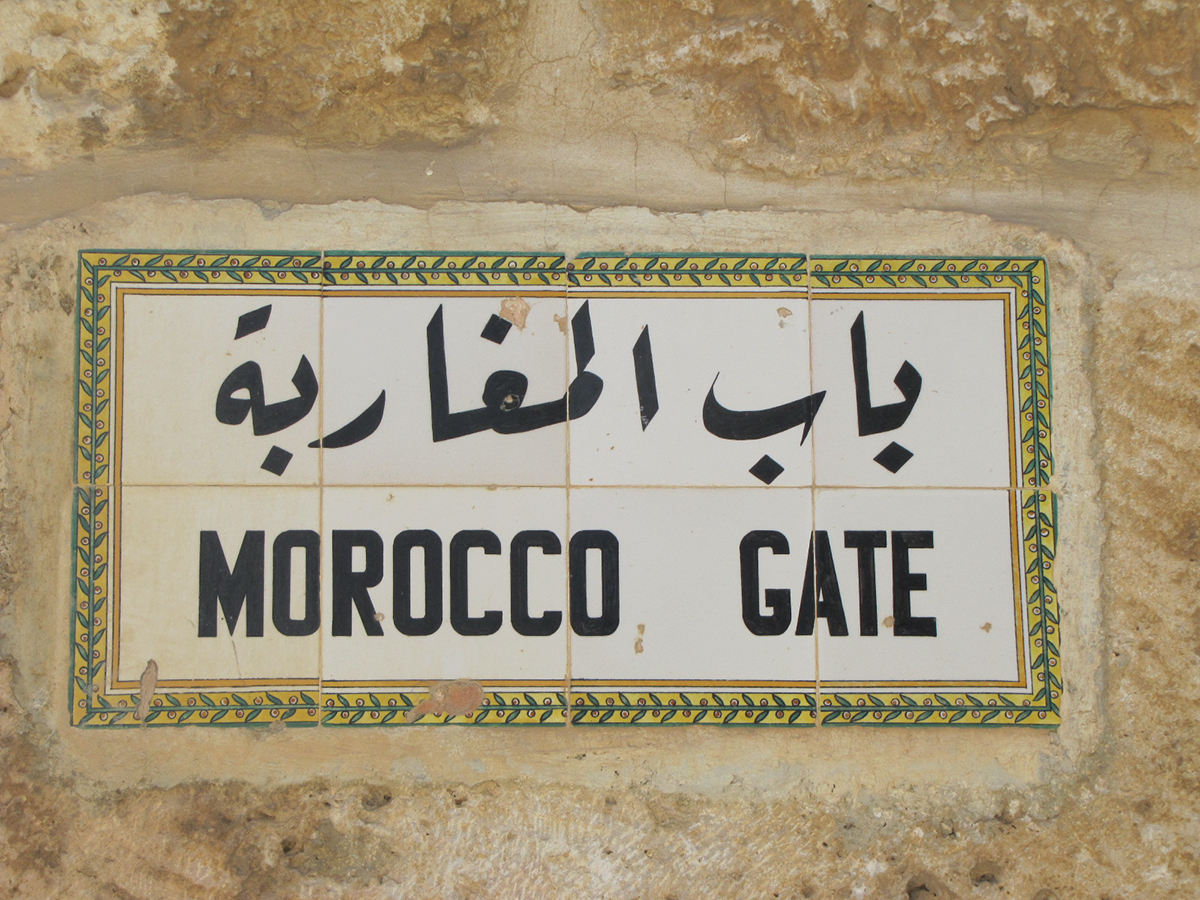
The Arabic and English sign for the Morocco Gate is posted in painted tile.
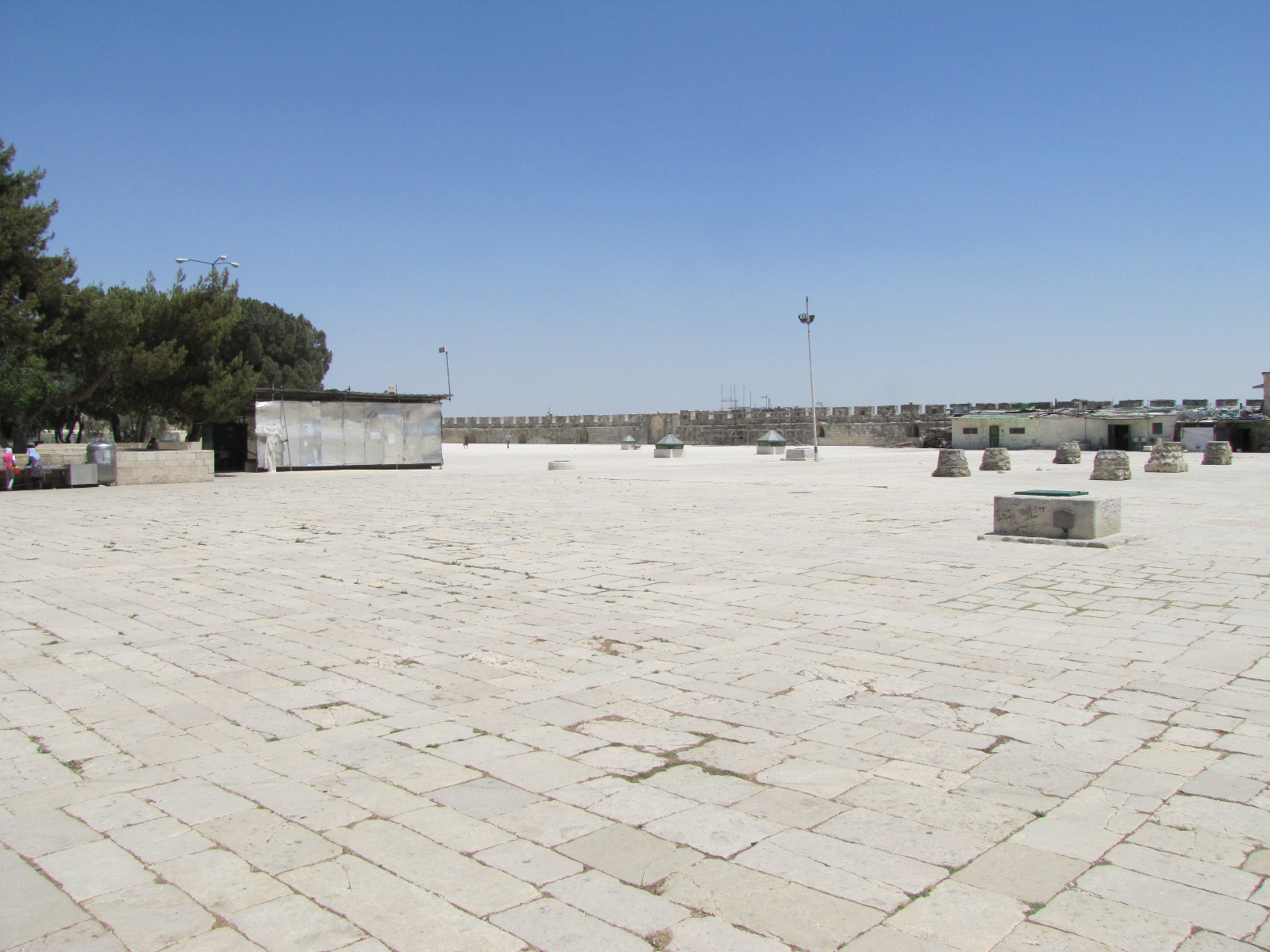
A view of the southern wall of the Temple Mount with the Cup fountain behind and the Al-Aqsa Mosque to the right. Notice the pavement stones. Herod’s Temple Mount stones are about 3 feet below these.
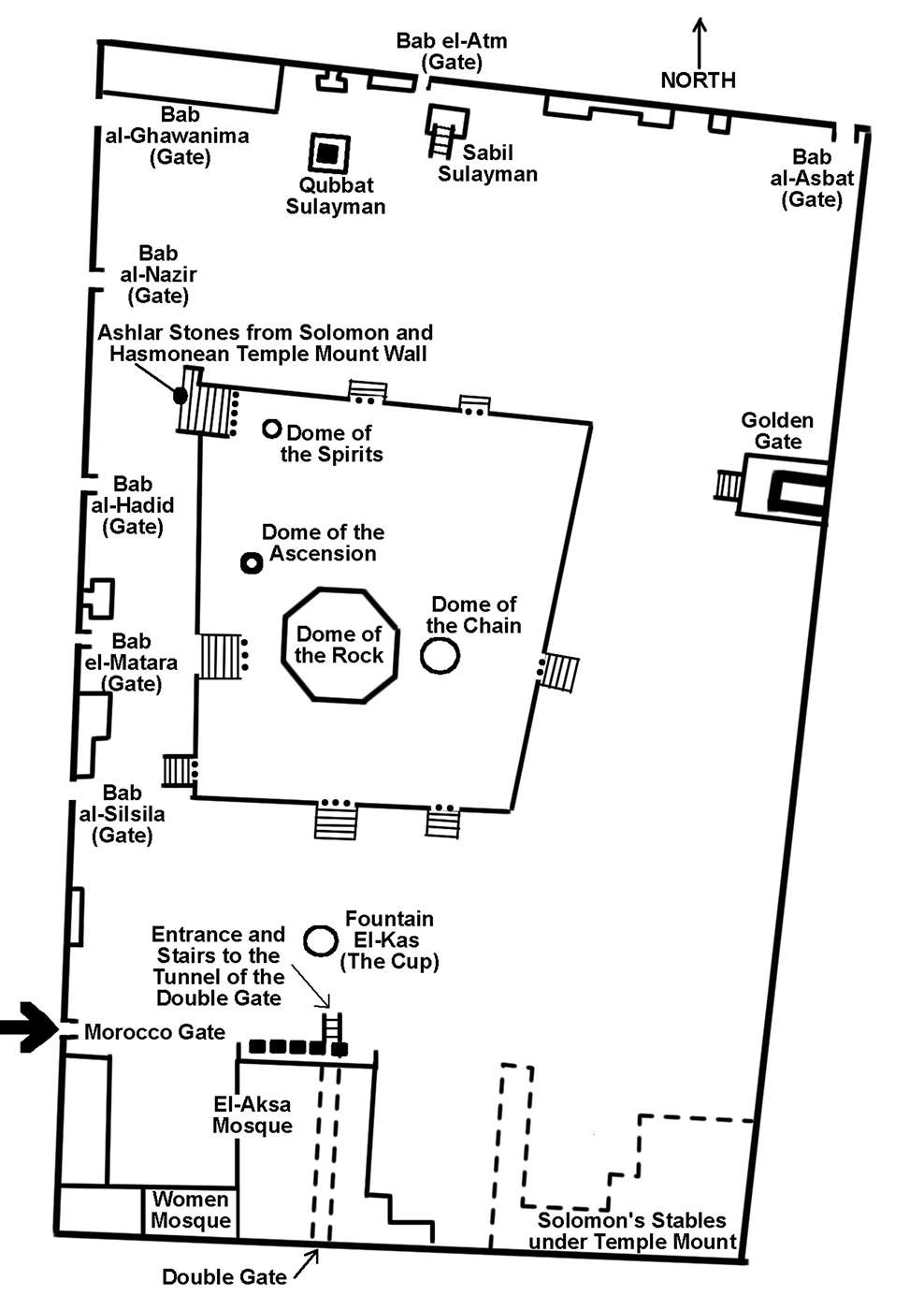
This is the layout of the 35 acres on the Temple Mount today. The Muslims call this “The Noble Sanctuary,” or “Al-Haram al-Sharif.” Today the Dome of the Rock sets where the Jewish Temple used to be, and the Dome of the Chain where the Altar of Burnt Offering was. The Morocco Gate (also, Mugrabi Gate and Gate of the Moors – or in Arabic Bab al-Magharbeh, and in Hebrew: Shaar HaMughrabim) is located on the Western Wall. Barclay's Gate was covered up over time as the ground outside the Temple Mount rose above the lintel of the gate. A new gate called Bab al-Magharbeh was installed in the Western Wall above the level of the Barclay Gate. The local residents of this part of Jerusalem at that time had come from Morocco, so the gate was named for them. This gate remains open today. It is the only entrance to the Temple Mount non-Muslims are allowed to use.
The Time Between 70 AD and 638 AD
When the Muslims conquered Jerusalem in 638 there were no buildings on the Temple Mount to destroy. The Christians had left the Temple Mount in ruins, and had even used it as a garbage dump. The temple was completely destroyed by the Romans in 70 AD, but they found it too difficult to dismantle the entire massive stone wall enclosing the Temple Mount.
In 132-135 AD, after their second revolt against Rome, the Jews may have attempted to rebuild the Temple.
In 135 Hadrian built a temple to Jupiter on the Temple Mount along with two statues of Roman emperors.
In 363 the Roman emperor Julian the Apostate gave the Jews permission to rebuild their temple. He did this to spite the Christians. However, the Jews did not get far, since Julian died in battle against the Persians that same year. Ammianus Marcellinus, a friend of Julian wrote:
Julian thought to rebuild at an extravagant expense the proud Temple once at Jerusalem, and committed this task to Alypius of Antioch. Alypius set vigorously to work, and was seconded by the governor of the province; when fearful balls of fire, breaking out near the foundations, continued their attacks, till the workmen, after repeated scorching, could approach no more: and he gave up the attempt.
The earthquake in Galilee in 363, sabotage, an accidental fire, and a lack of Jewish commitment to the project may have been the real reasons it was abandoned. Of course, the death of Julian and the possibility of Divine intervention were also heavy factors leading to the end of the Temple building in 363.
From 363 until 638 there was no building activity on the Temple Mount under the Christian emperors of Rome or Byzantium.
When the Muslims took the city of Jerusalem from the Christians in 638 AD, the Caliph Omar was given a tour of the city by the patriarch of Jerusalem, a Christian monk named Sophronius. Omar wanted to see the spot where the Jewish Temple had been. For six centuries the Christians had let the Temple Mount lie in ruins in order to fulfill Jesus’ words that “there will not be left here one stone upon another.” In fact, they used it as a garbage dump.
A simple wooden sanctuary was built south of the Jewish Temple, and around 660 a house of prayer was built on the Temple Mount “at the blessed site where the Temple stood.” According to the writings of Arculf, a Christian visitor to Jerusalem from 679-688, the Muslims had “built an oblong house of prayer, which they pieced together with upright planks and large beams over some ruins” at “that famous place where once there stood the magnificent Temple.”
In the minds of the early Muslims (and as recorded in their writings), the buildings they eventually built on the Temple Mount constituted the restoration of the Jewish site. The Dome of the Rock was the Muslim version of the Temple restored. It competed with the Church of the Holy Sepulcher in Jerusalem and with the shrines in Mecca and Medina of internal Muslim political opponents.
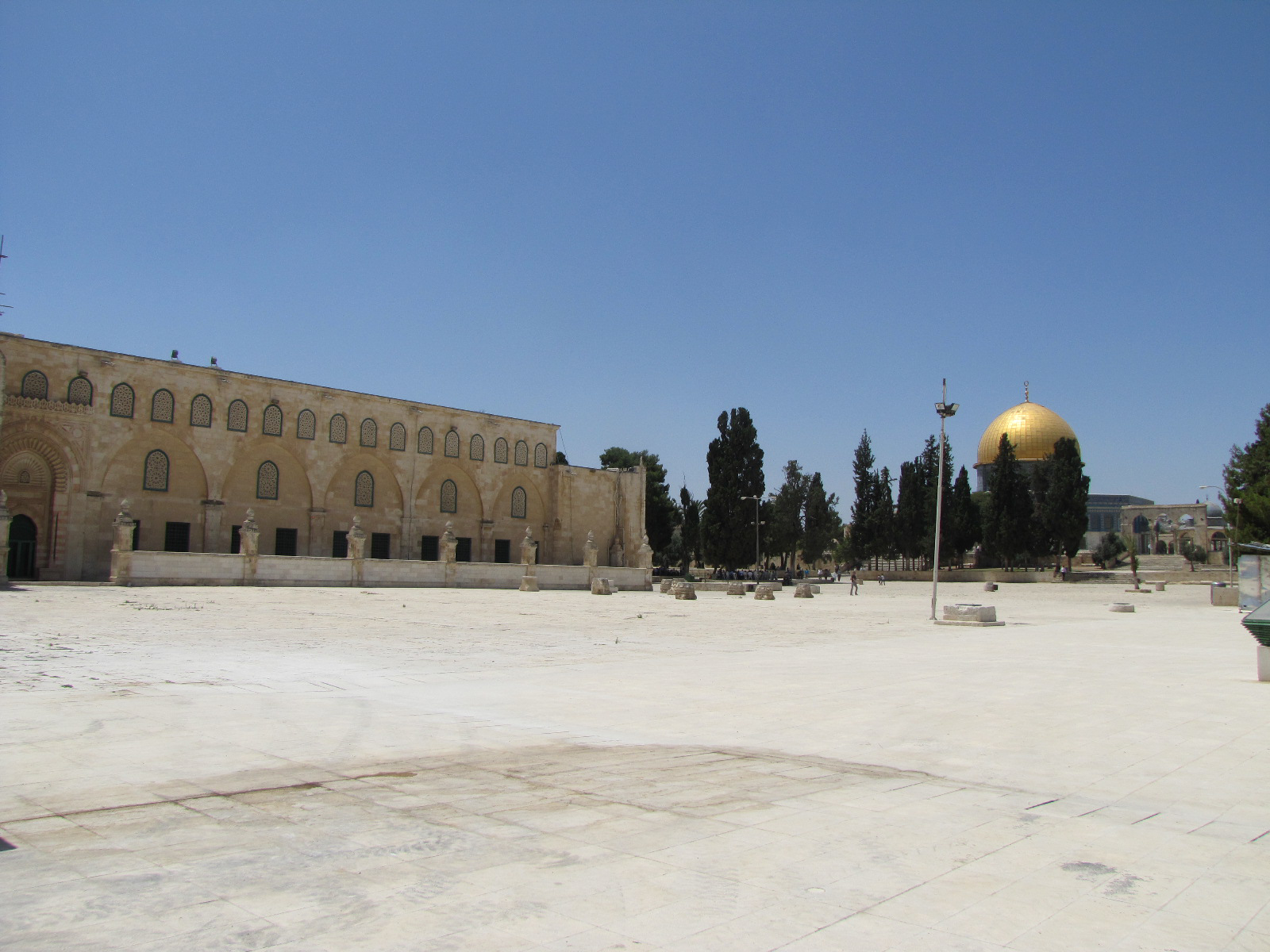
This photo was taken standing against the southern wall of the Temple Mount between the Double Gate and the Triple Gate, looking north-northwest. The Al-Aqsa Mosque is on the left, and the Dome of the Rock is in front and to the right of center.
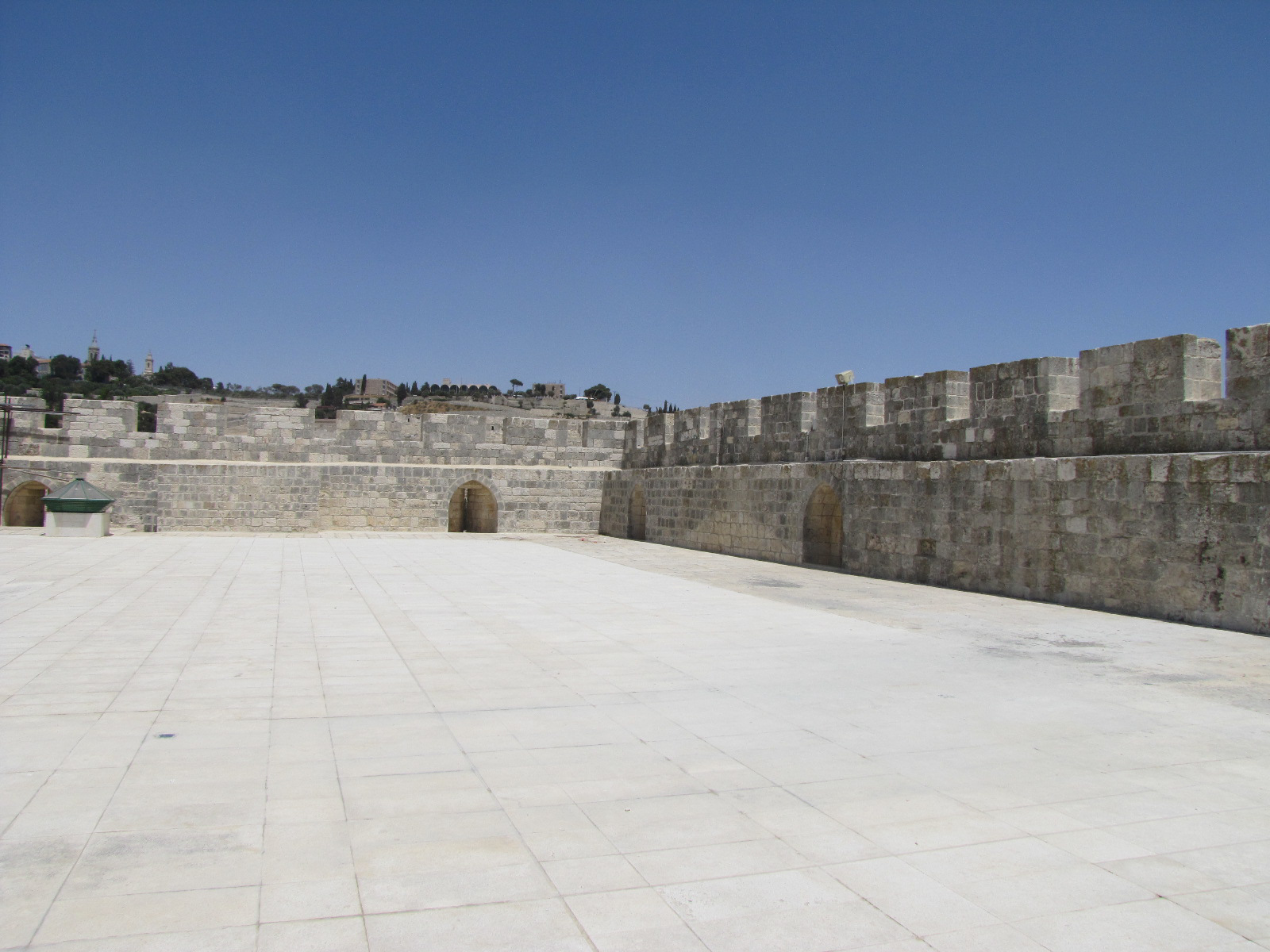
Looking east at the southeast corner of the Temple Mount. The Mount of Olives is in the background. Solomon's Stables are directly below. The Triple Gate is to the right and down (on the other side of the wall).
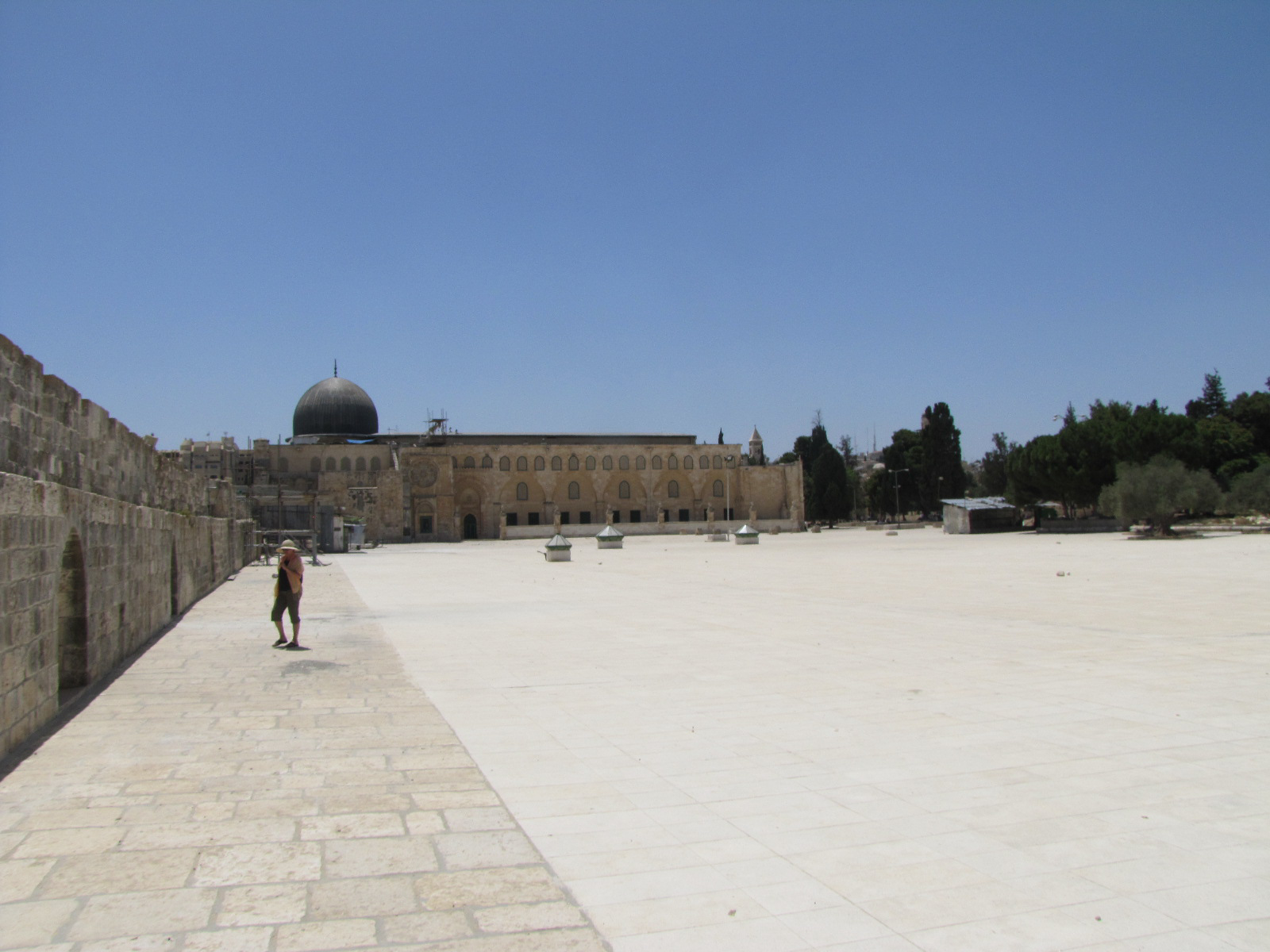
This photo was taken from the southeast corner of the Temple Mount wall looking west. Toni is walking toward the southern wall. The Al-Aqsa Mosque with its dome is the building in the center of the photo. Notice the wide open space, but also the trees to the right. In certain places on the Temple Mount there are many trees, including both older trees and newly planted ones.
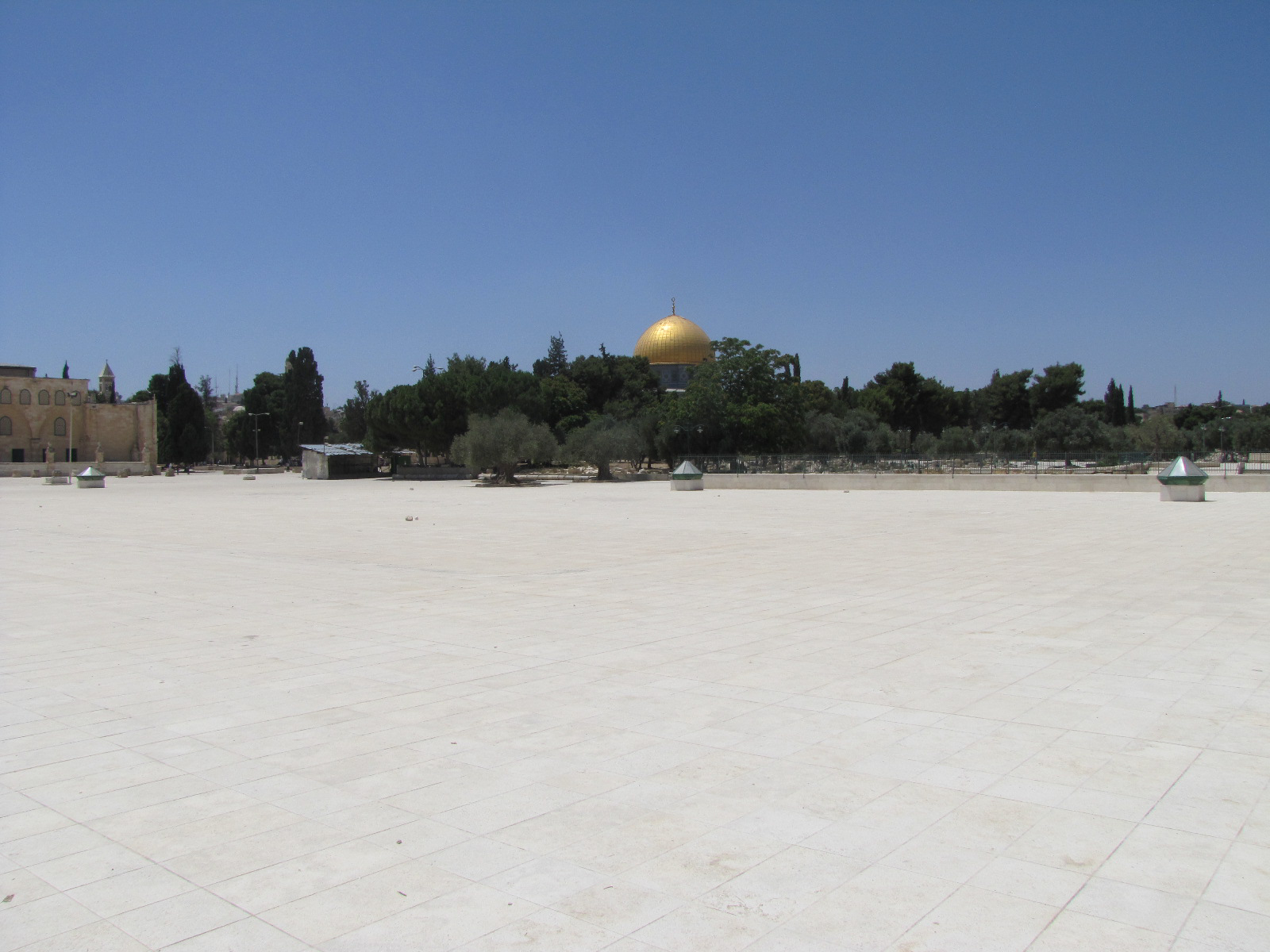
Standing in the southeast corner of the Temple Mount looking northwest at the Dome of the Rock.
Both Jewish and Muslim tradition says that Mount Moriah is Eden and that the rivers of Eden flow beneath the Temple Mount. The book of Jubilees, which was written in the 100’s BC and was considered authoritative scripture by the Dead Sea community, says:
The Garden of Eden was the Holy of Holies and the dwelling of the Lord. - Jubilees 8:19
The inside of Solomon’s Temple was filled with engraved trees:
Around all the walls of the house he carved engraved figures of cherubim and palm trees and open flowers, in the inner and outer rooms.- 1 Kings 6:29
The interior of the Dome of the Rock also includes mosaics with tree, foliage, bush, jewel and floral motifs.
Hershel Shanks records in his book Jerusalem’s Temple Mount:
Yassar Arafat told the American negotiator Dennis Ross, and others, that even if Herod’s Temple did exist, it was not in Jerusalem, but in Nablus, a city about 30 miles north of Jerusalem. Arafat was referring to the Samaritan Temple on Mt. Gerizim (in Nablus).” Arafat admitted to President Clinton at Camp David that his faith forbade him from recognizing the existence of the Jewish Temple saying, ‘I am a religious man and will not allow it to be written of me [in history] that I have ...confirmed the existence of the so-called temple underneath the mountain.”
But Arafat did admit the existence of Herod’s Temple when he said:
“The Jews have no claim to the whole area of the Haram al-Sharif. They [the Israelis} excavated everywhere and they didn’t find a single stone from the Temple [of Solomon], just some stones from the Temple of Herod. (Jerusalem’s Temple Mount:From Solomon to the Golden Dome, by Hershel Shanks, The Continuum International Publishing Group Inc., 2007, page 3.)
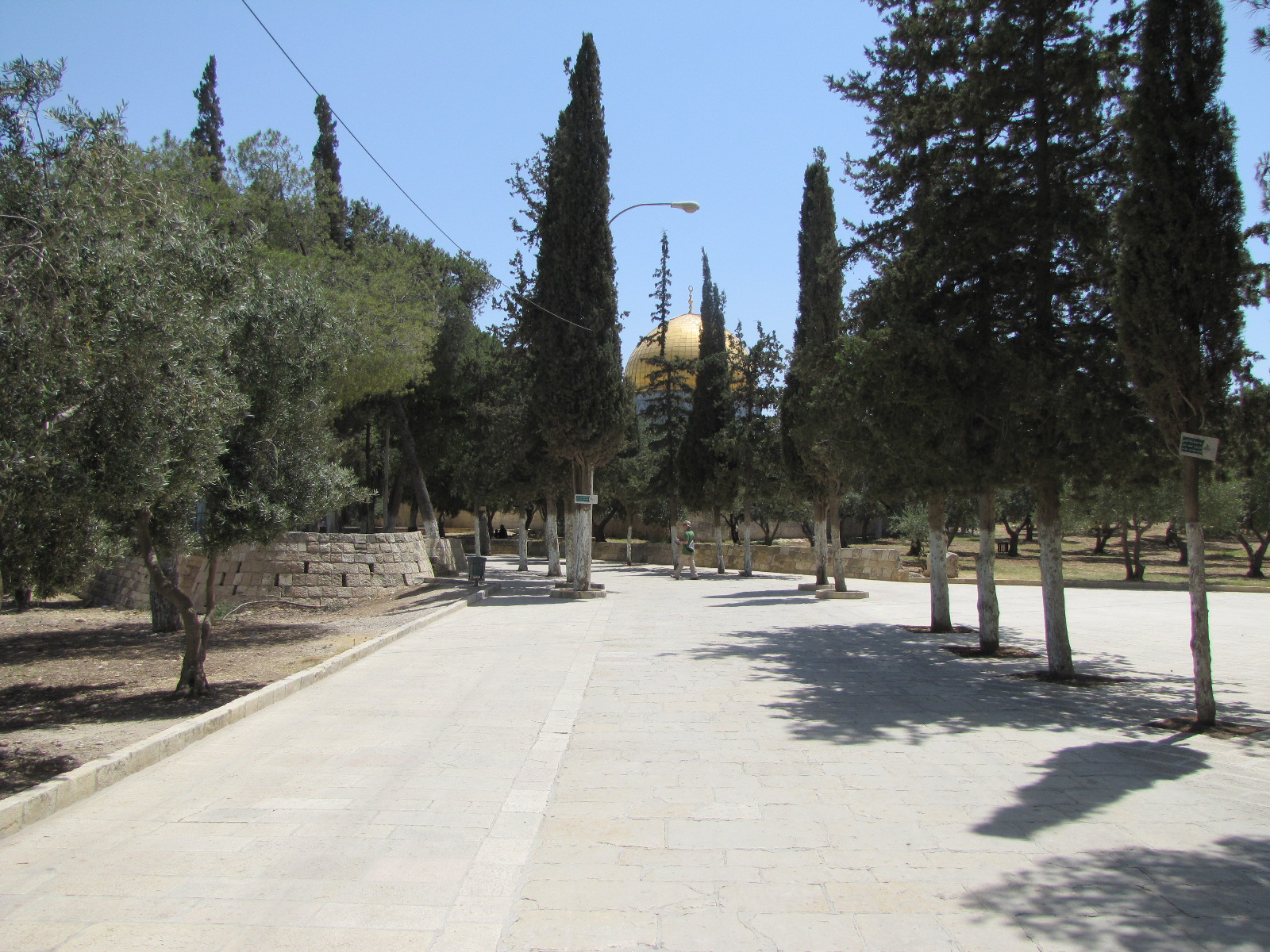
Standing to the north of the Dome of the Rock looking south through the trees.
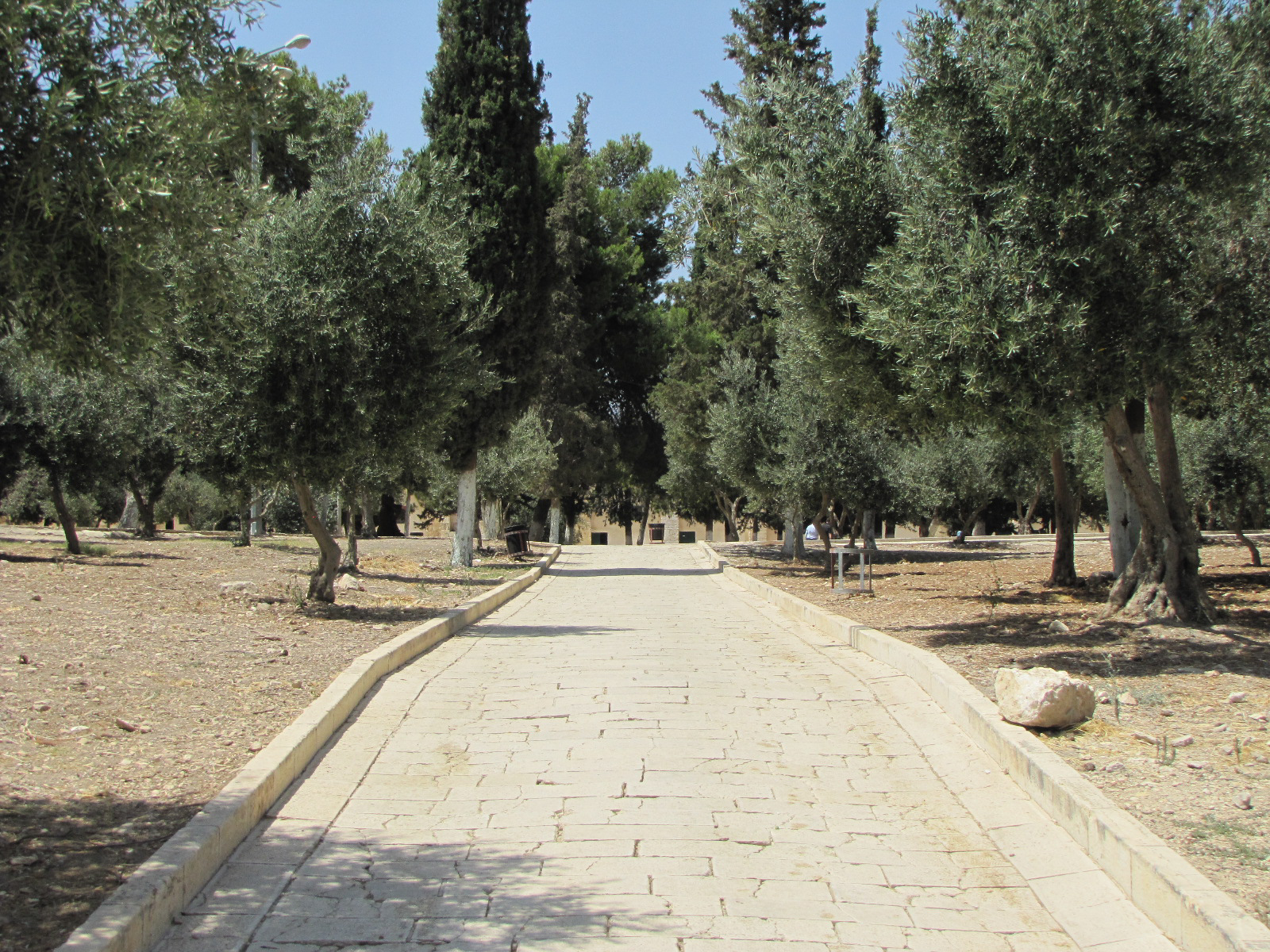
Looking west between the Dome of the Rock on the left and the northern wall on the right.
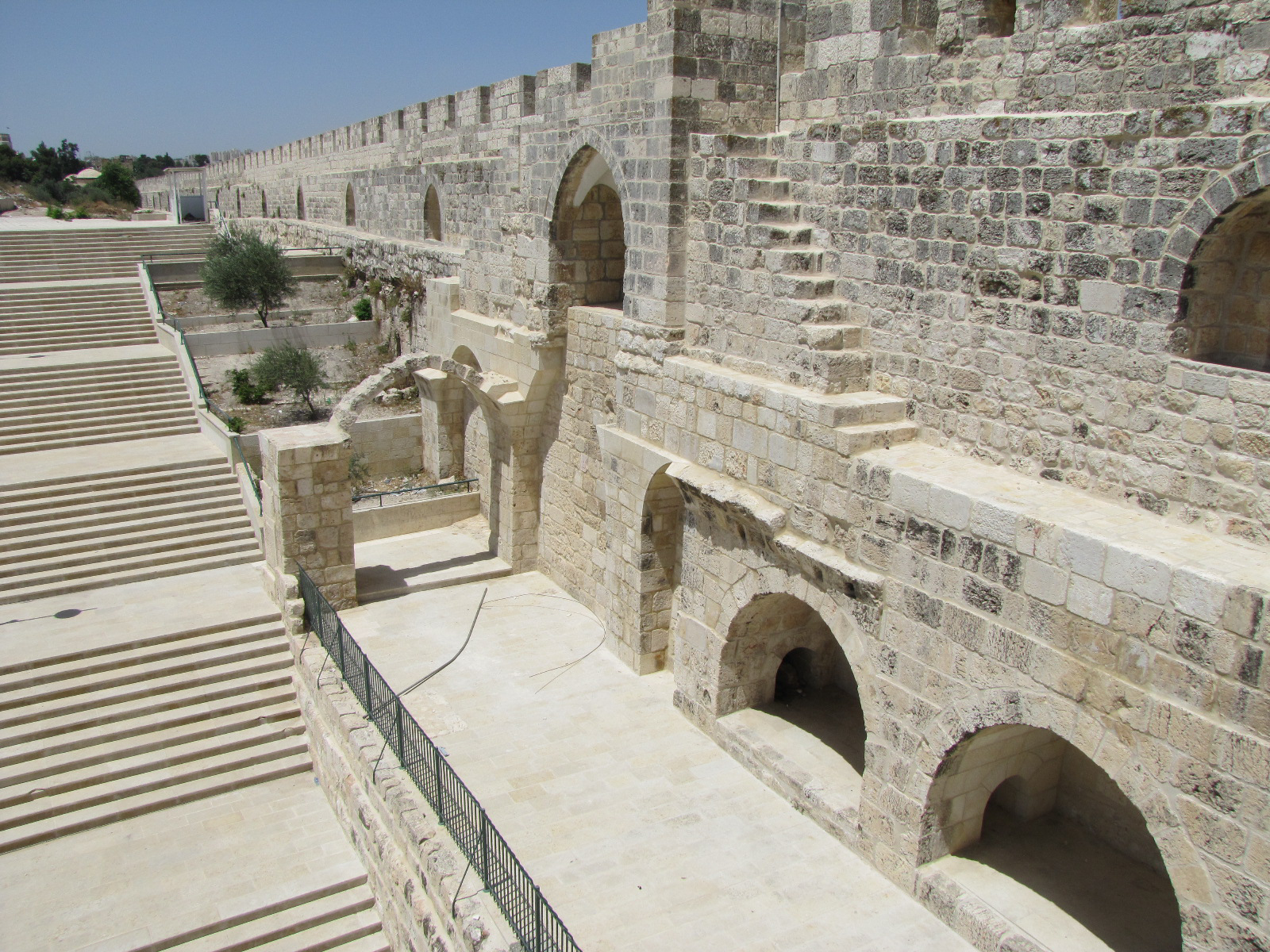
Beginning in 1996 the Muslim Waqf (the Muslim group that is charged with overseeing the Temple Mount) began working on and under the Temple Mount to create this large stairway down into what the Crusaders called "Solomon's Stables". There was no archaeological oversight of this enormous project, although much ancient soil and all its archaeological
remains were removed with bulldozers and other types of heavy equipment.
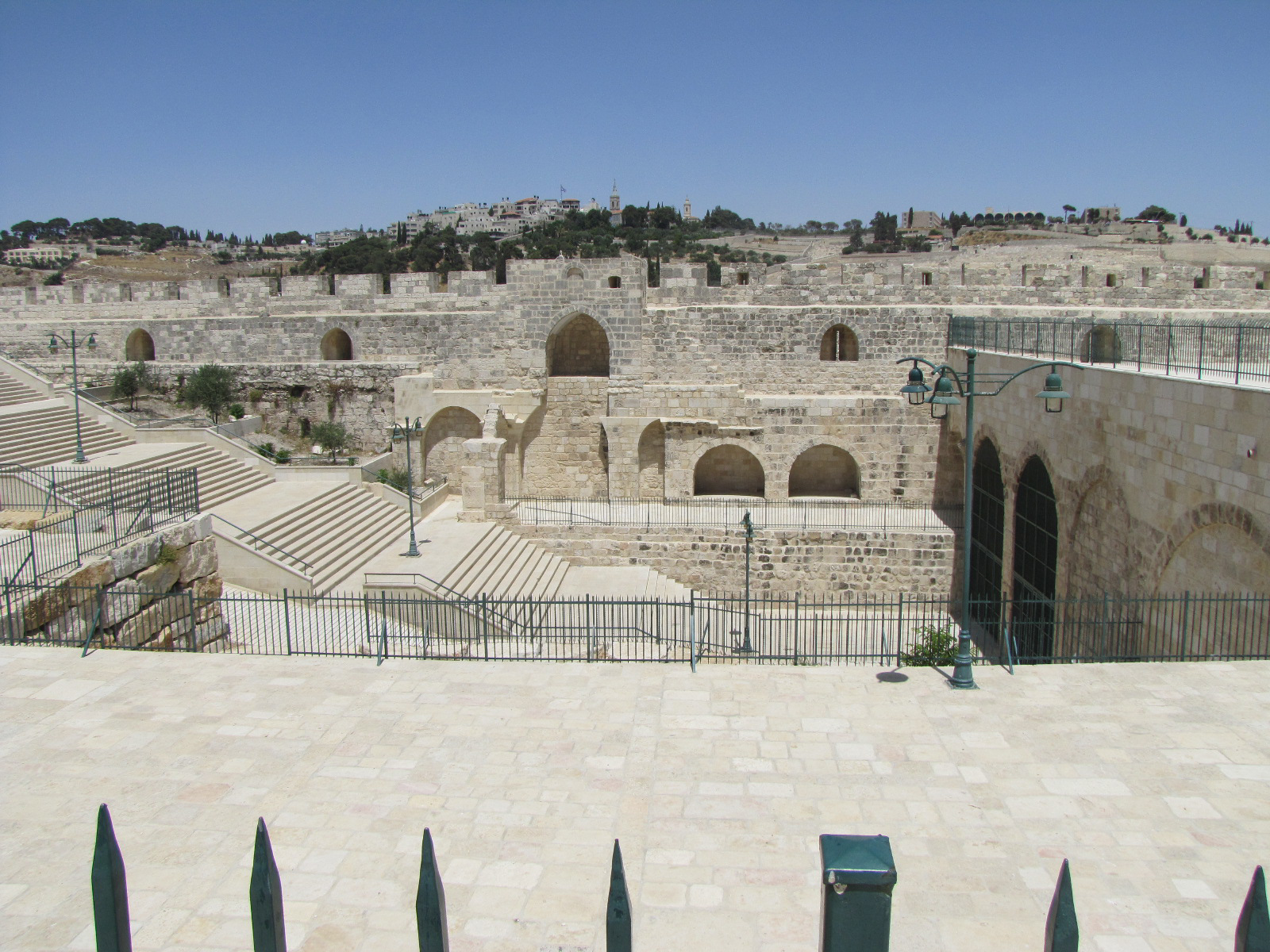
The Muslims claim that there is an ancient mosque in Solomon's Stables on the other side (right/south) of the large arched doors at the bottom of the staircase. While it is not an ancient mosque, by the time the illegal and unauthorized construction was done, it did house the Marwani Musalla Mosque, which can hold up to 7,000 people. The excavated area that we see in this photo is 18,000 square feet large and 36 feet deep. In 2001, Israeli police watched bulldozers destroy ancient structures. The archaeological soil was removed in hundreds of truck loads and dumped into in the Kidron Valley. There are reports that remains from the 700’s BC and from the Solomon’s Temple, Hasmonean symbols, decorated Temple stones with ancient Hebrew inscriptions, and innumerable potsherds and pottery from both Herod’s Temple and the Roman period were uncovered during these destructive digs on the Temple Mount.
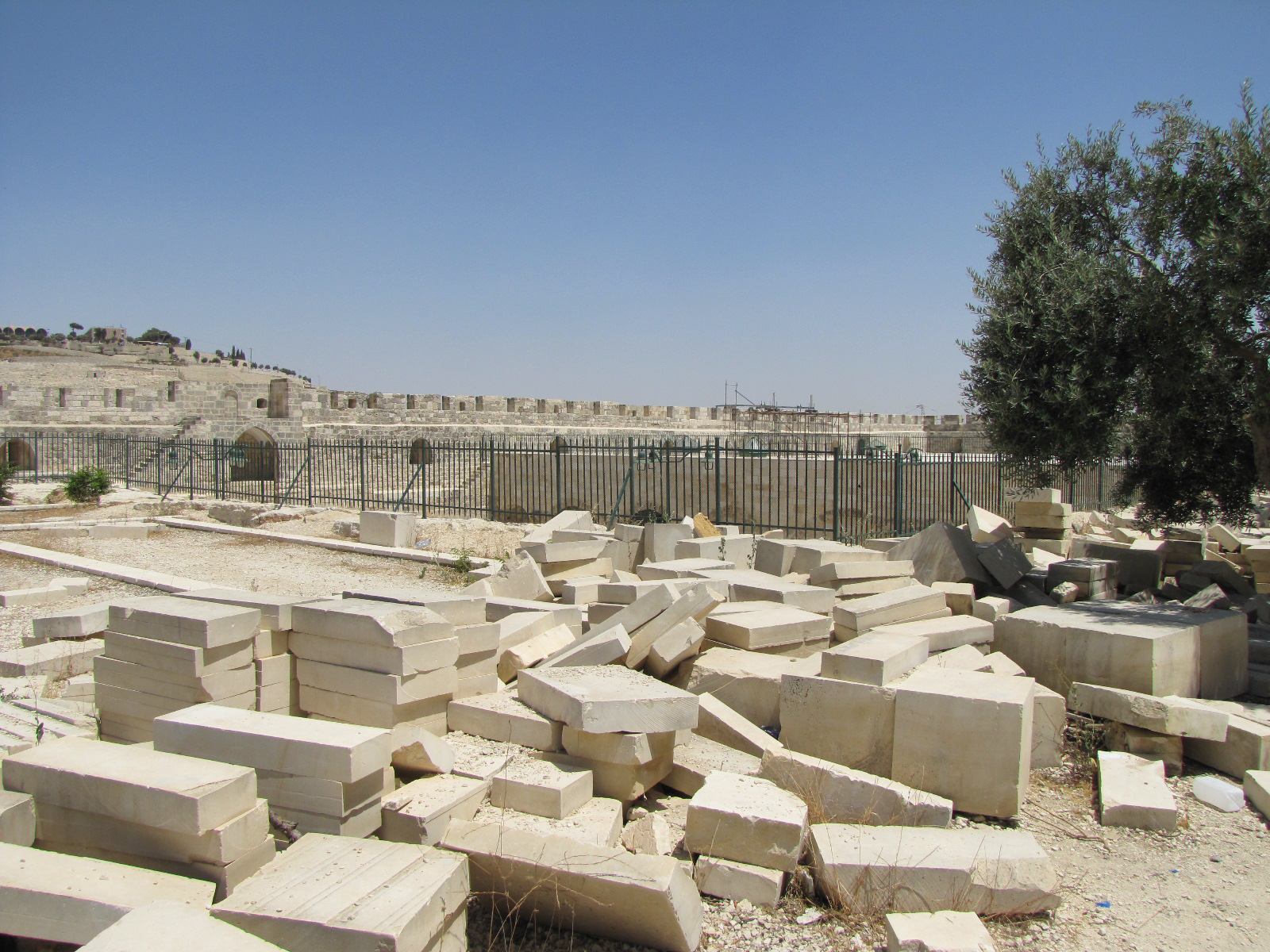
A supply pile of construction material still lies outside the fence near the new staircase down into the new mosque.
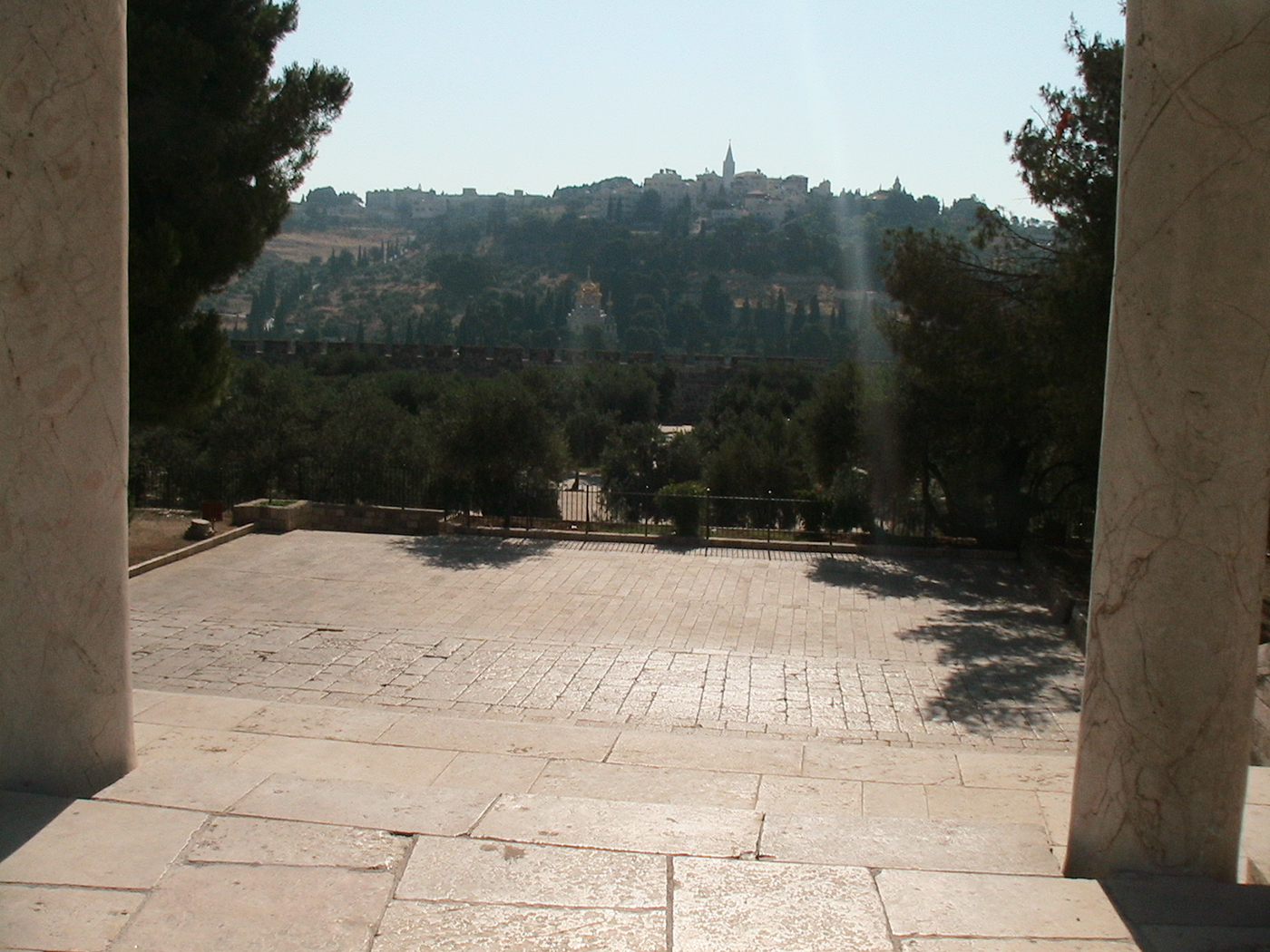
A view looking over the Kidron Valley at the Mount of Olives from the Temple Mount platform a few feet in front of the location of the Altar of Burnt Offering. The Red Heifer was sacrificed on the summit of the Mount Olives, so the High Priest who offered that sacrifice could have looked directly into the Temple. The Temple would be directly behind me when I took this photo.
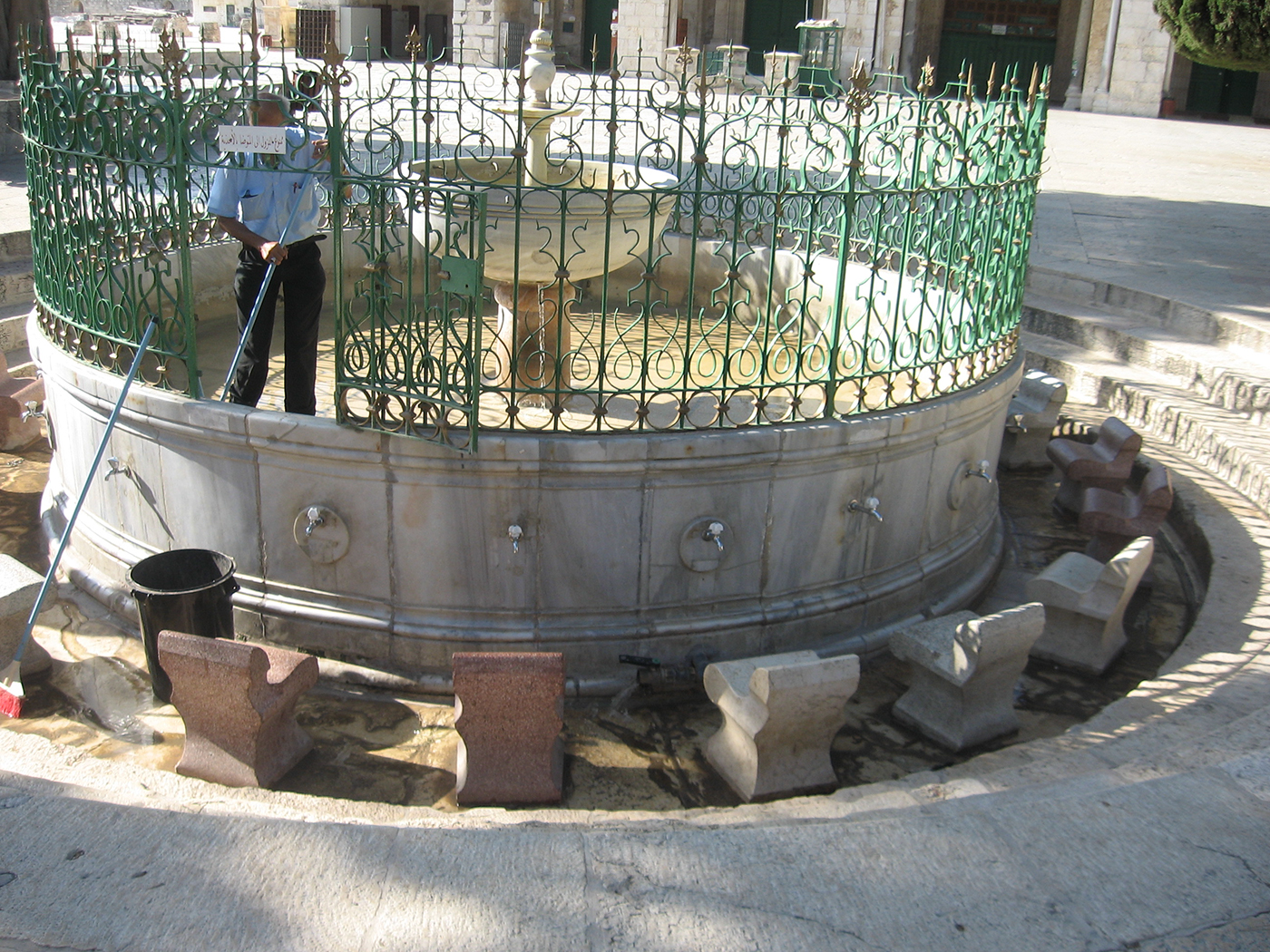
El Kas, or The Cup, used for Muslim purification. It is in front of Al-Aqsa (in the background) and the Dome of the Rock.

This photo was taken on the Muslim platform where the Dome of the Rock stands. The Herodian pavement is about 3 feet below this pavement. This view is looking north toward where the eastern courtyard of the Temple would have been. The Mount of Olives is to the right (east). To the left on the edge of the photo, where the columns of the Dome of the Chain are seen, is where the activities of Israel’s Altar of Burnt Offering would have occurred. The Temple, now the Dome of the Rock, is a little further to the left of this photo.
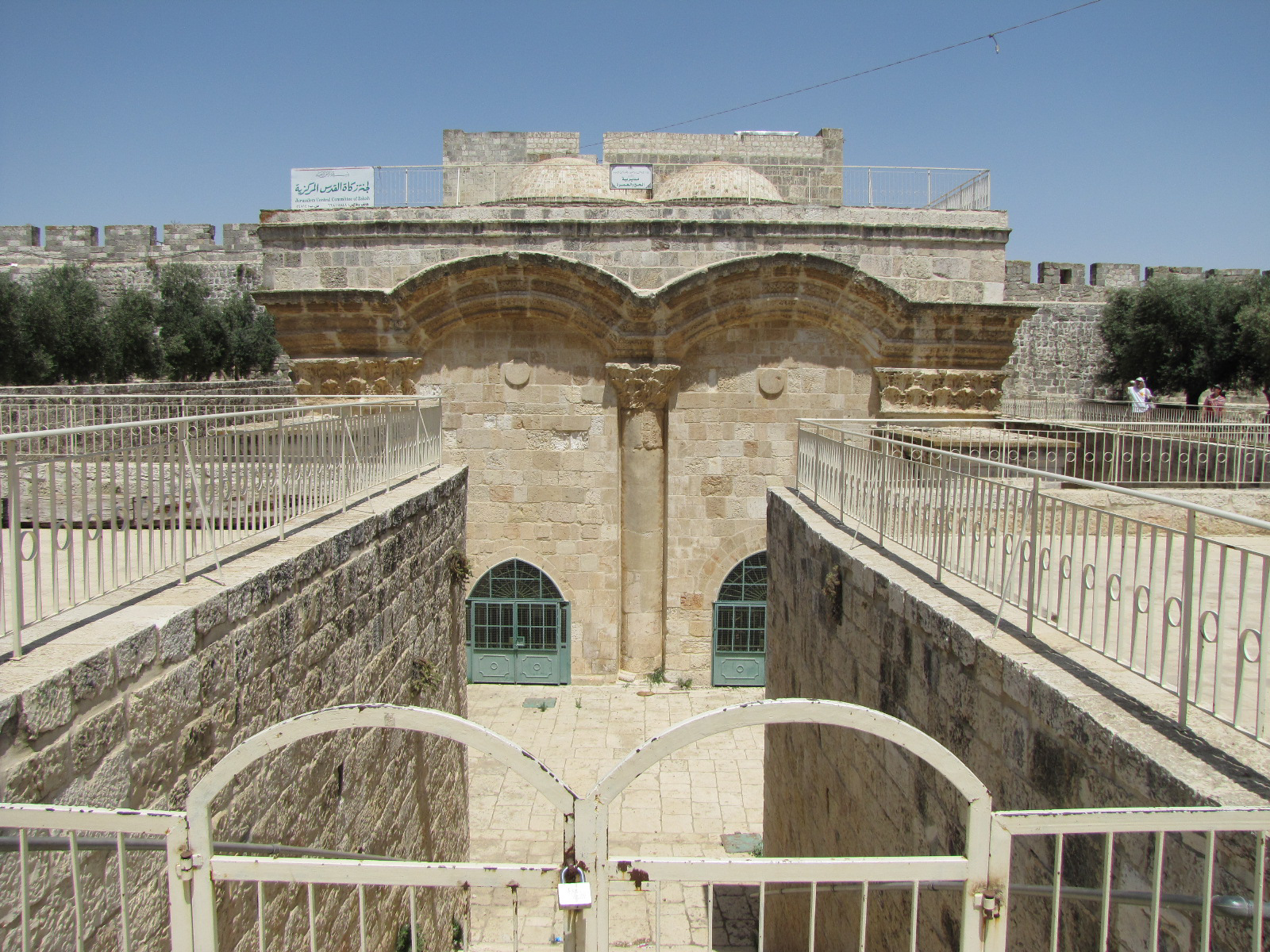
Inside the Golden Gate, or Eastern Gate. This photo is looking east. Notice that if the Gates were not blocked, a person entering would have to ascend a stairway to reach the ground level of the Temple Mount.
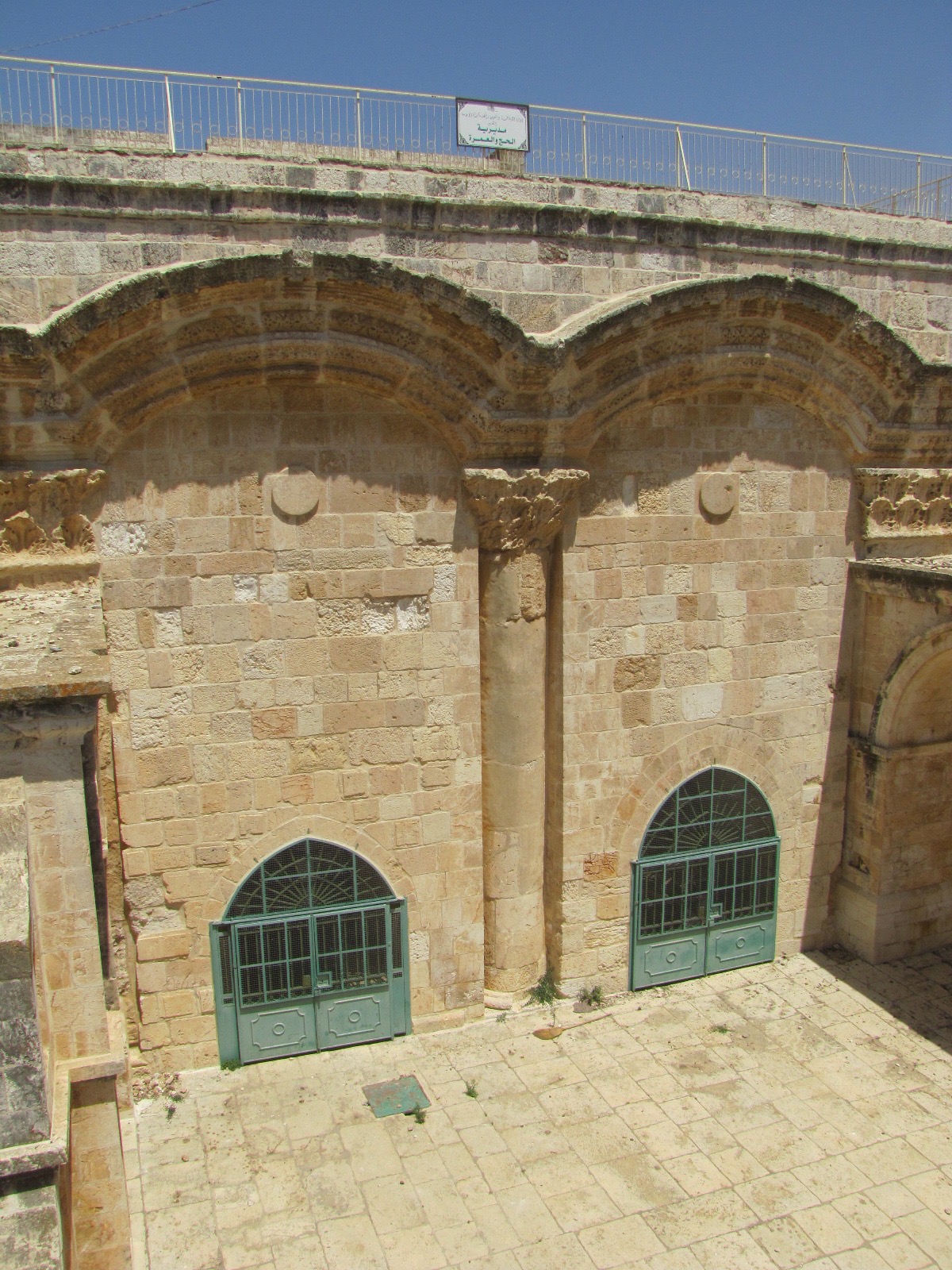
A close up of the inside of the blocked Golden Gate on the east side of the Temple Mount.
The Dome of Ascension (Qubbat al-Mi’raj) was built to the northwest of the Dome of Rock, on the same platform. It was built before the Crusaders arrived and is mentioned in documents dating from 903 AD. The current Dome of Ascension was rebuilt in 1200 AD using Crusader material. It is claimed to be the place from which Muhammad ascended to Heaven. Even early Muslim writings clearly indicate that the spot marked by the Dome of Ascension was believed to be the original spot of Muhammad’s legendary ascent into heaven. In more recent times, however, the location of Muhammad’s ascension to heaven has been moved inside in the Dome of the Rock in order to establish a Muslim claim of holiness to the location marked by the Dome of the Rock. Previously, the Muslim’s had claimed the rock under the Dome was the location of the Ark of the Covenant kept inside the Most Holy Place of Solomon’s Temple.The inscriptions above the columns inside the Dome of the Rock make no mention of Muhammad ascending from the rock beneath the Dome of the Rock, nor do they mention the night journey of Sura 17:1.
The Dome of the Rock was built over the rock that was the apex of Mount Moriah (Moriah means “Yahweh is seen [here]”). It is the place where Solomon built his temple, according to 2 Chronicles 3:1:
Solomon began to build the House of the Lord in Jerusalem on Mount Moriah. - 2 Chronicles 3:1
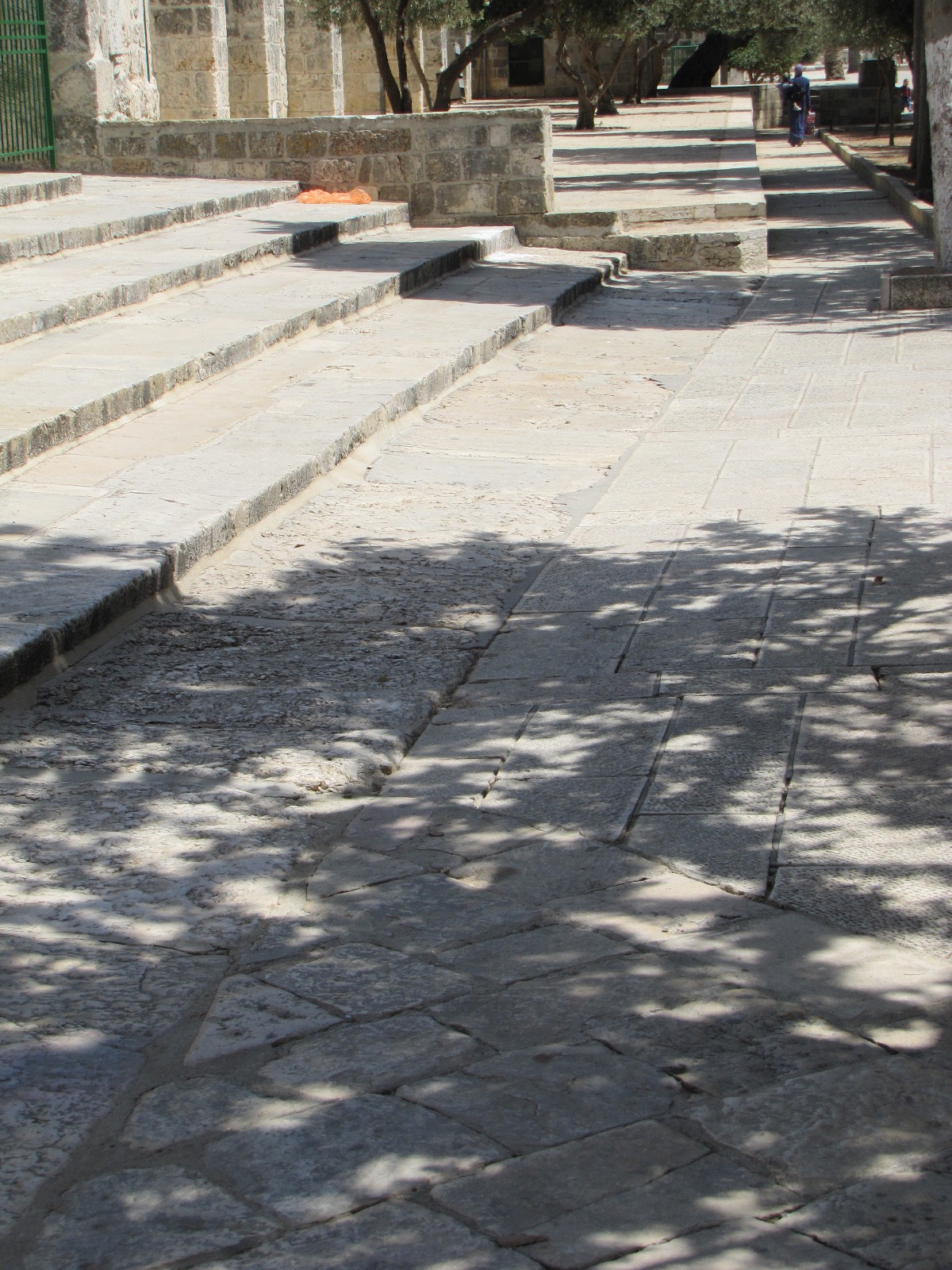
The northwest stairs that take people up to the Muslim platform from the ground level of the Temple Mount. Notice, as mentioned earlier, the bottom row of steps that are the same level as the Temple Mount pavement stones. This is the outside of the Western Wall of the Temple Mount of the Old Testament and of the Hasmoneans. It is not running in a straight line with the Muslim platform seen in the background.
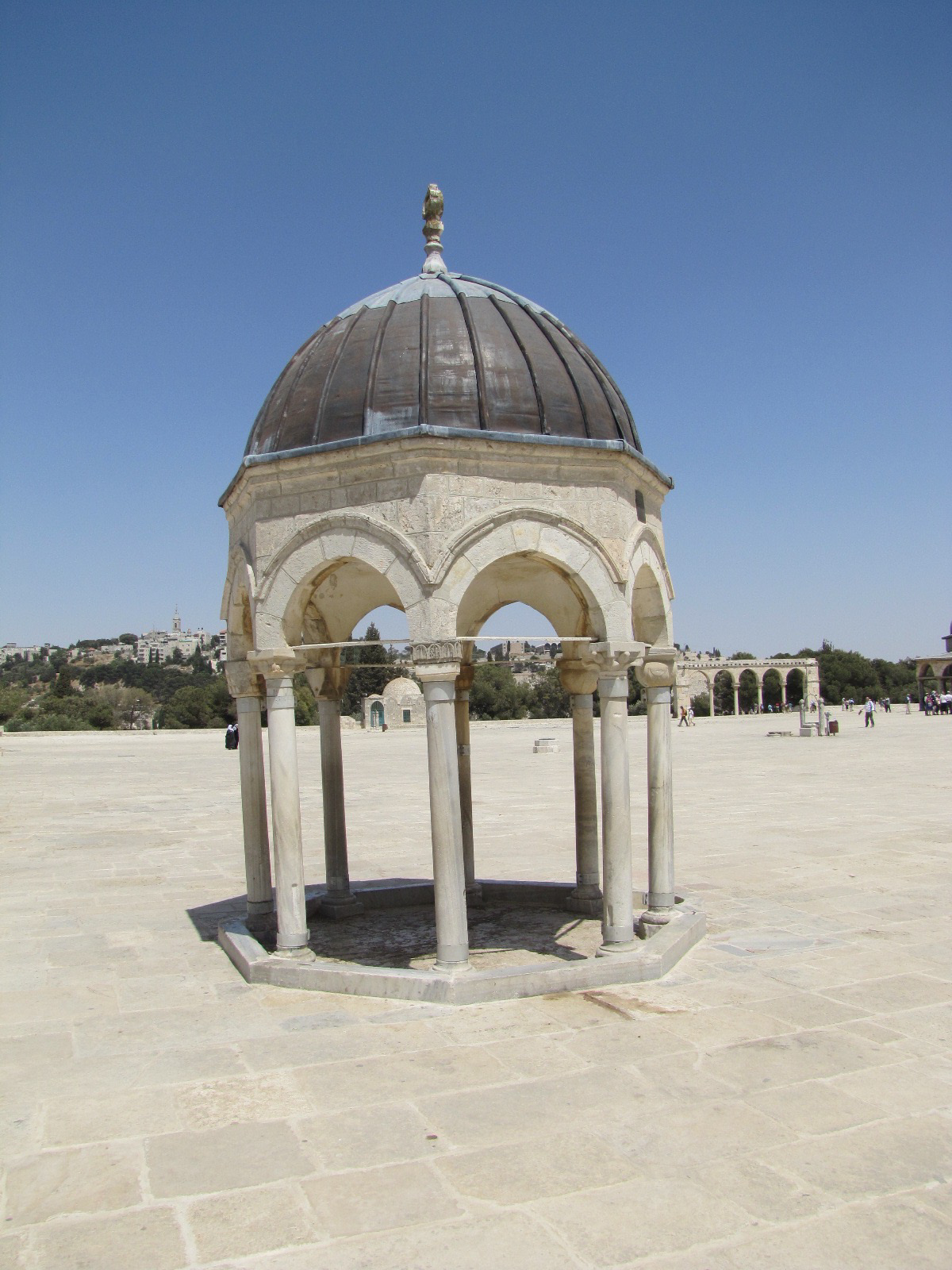
The Dome of Ascension as viewed from westnorthwest looking east-southeast. According to early Muslim tradition Muhammad ascended into heaven from here. The Mount of Olives is in the background, and the edge of the Dome of the Chain is in the middle of the right edge of this photo.
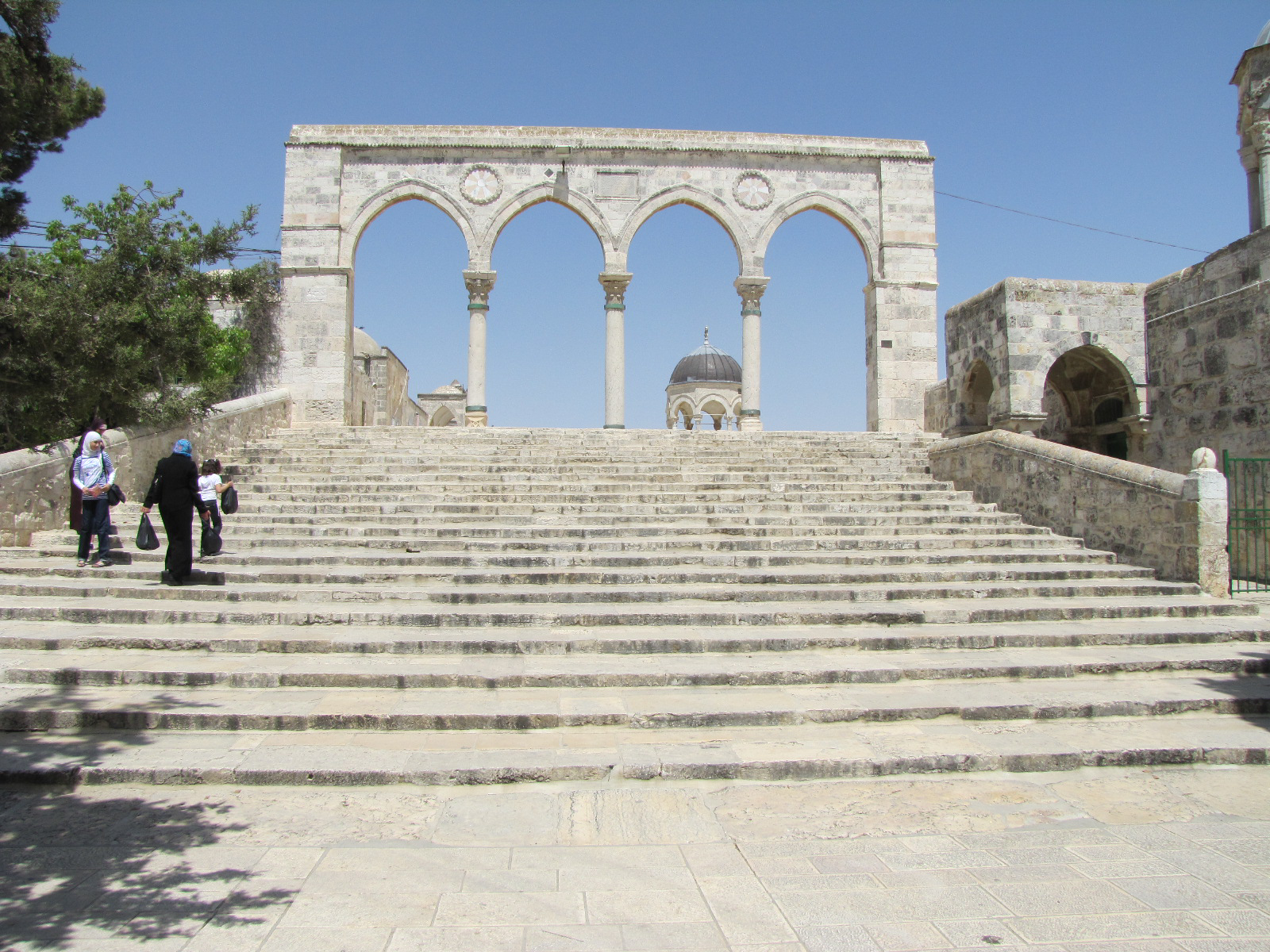
These are the northwest steps from the Temple Mount pavement up to the Muslim platform. The small dome at the top of the stairs is the Dome of Ascension. This is where Muhammad’s legendary ascent into Heaven supposedly began.
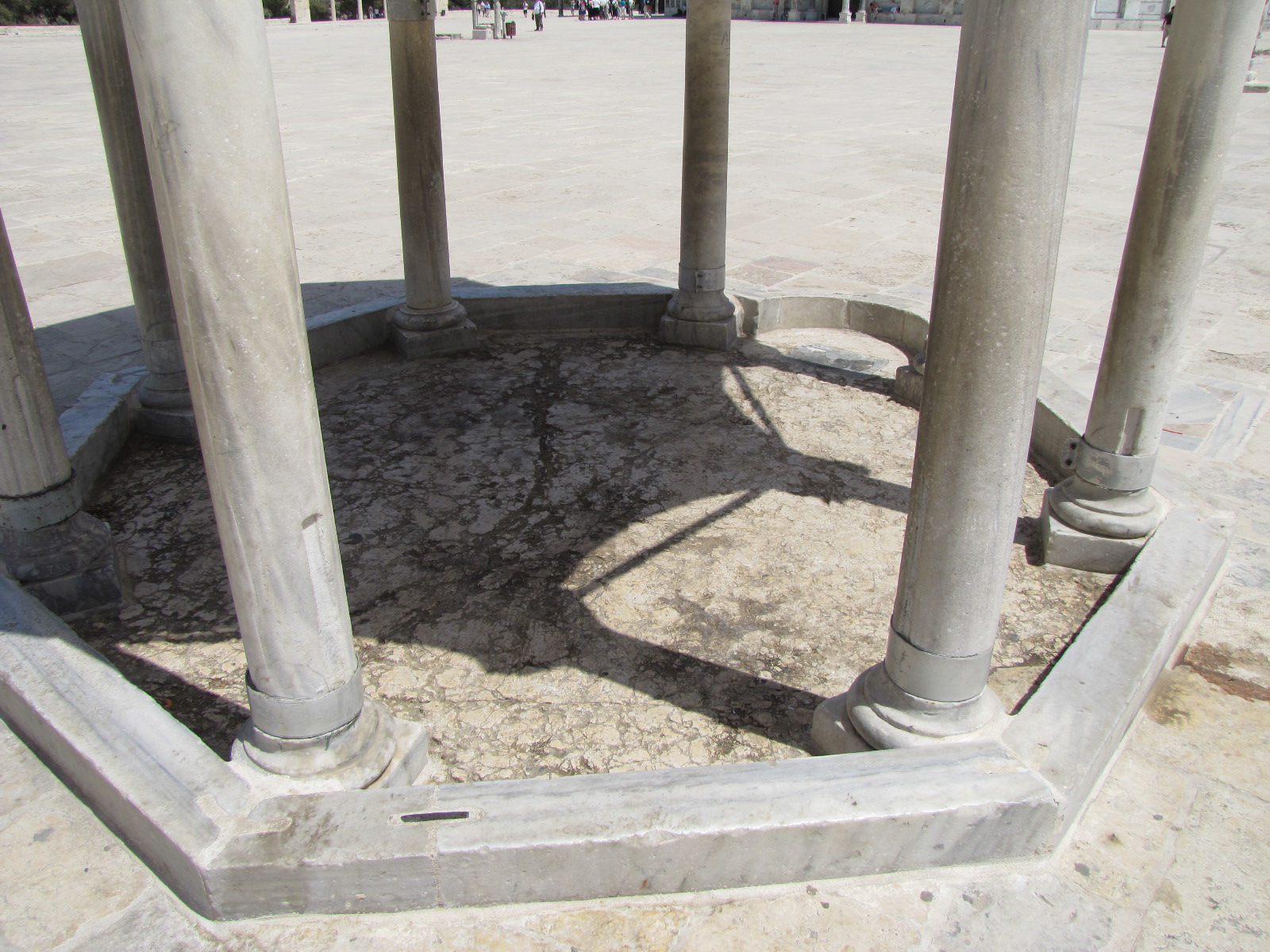
The bedrock of Mount Moriah can be seen under the Dome of the Ascension. This is what the bedrock covered by the Dome of the Rock looks like. Some theories regarding the location of the Temple of Solomon place the Holy of Holies right here. But according to tradition, scripture and archaeology, the Holy of Holies was most likely under the Dome of the Rock.
Several Temple Mount gates are currently open:
1. Gate of the Tribes (Bab al-Asbat) - northeast corner
2. Gate of Remission (Bab al-Huttah) - north side
3. Gate of Darkness (Bab al-Atim) - north side
4. Gate of Bani Ghanim (Bab al-Ghawanima) - northwest corner
5. Council Gate/Inspector's Gate (Bab al-Nazer) - west side
6. Iron Gate (Bab al-Hadid) - west side near the "Little Western Wall"
7. Cotton Merchant's Gate (Bab al- Qattanin) - the Dome of the Rock can be viewed through this gate on the west side
8. Ablution Gate (Bab al-Matarah) - west side
9. Tranquility Gate (Bab al-Salam) - west side
10. Chain Gate (Bab al-Silsileh) - west side and may be the Kiponos Gate from Herod's temple which is one of four gates on the west side of the Temple Mount mentioned by Josephus.
11. Mugrabi Gate (Bab al-Magharbeh) - west side; used by non-Muslims
These six gates of the Temple Mount are sealed closed:
• Golden Gate (Bab al-Zahabi) - east side; built around 520 by Justinian I on top of the ruins of the original Eastern Gate
• Single Gate - south side; once led under the Temple Mount
• Huldah Gates (Bab al-Thulathe) - south side; the Huldah Gates are two sets of gates (the Double Gate, which is partially blocked by a Crusader tower and used to lead to the Temple Mount, and the Triple Gate which also led to steps leading to the surface of the Temple Mount)
• Barclay's Gate - a gate from Herod's temple (aka, the Coponius' Gate) located under the Mugrabi Gate
• Warren's Gate - a gate from the time of Herod's temple that led to a stairway that led to the surface of the Temple Mount
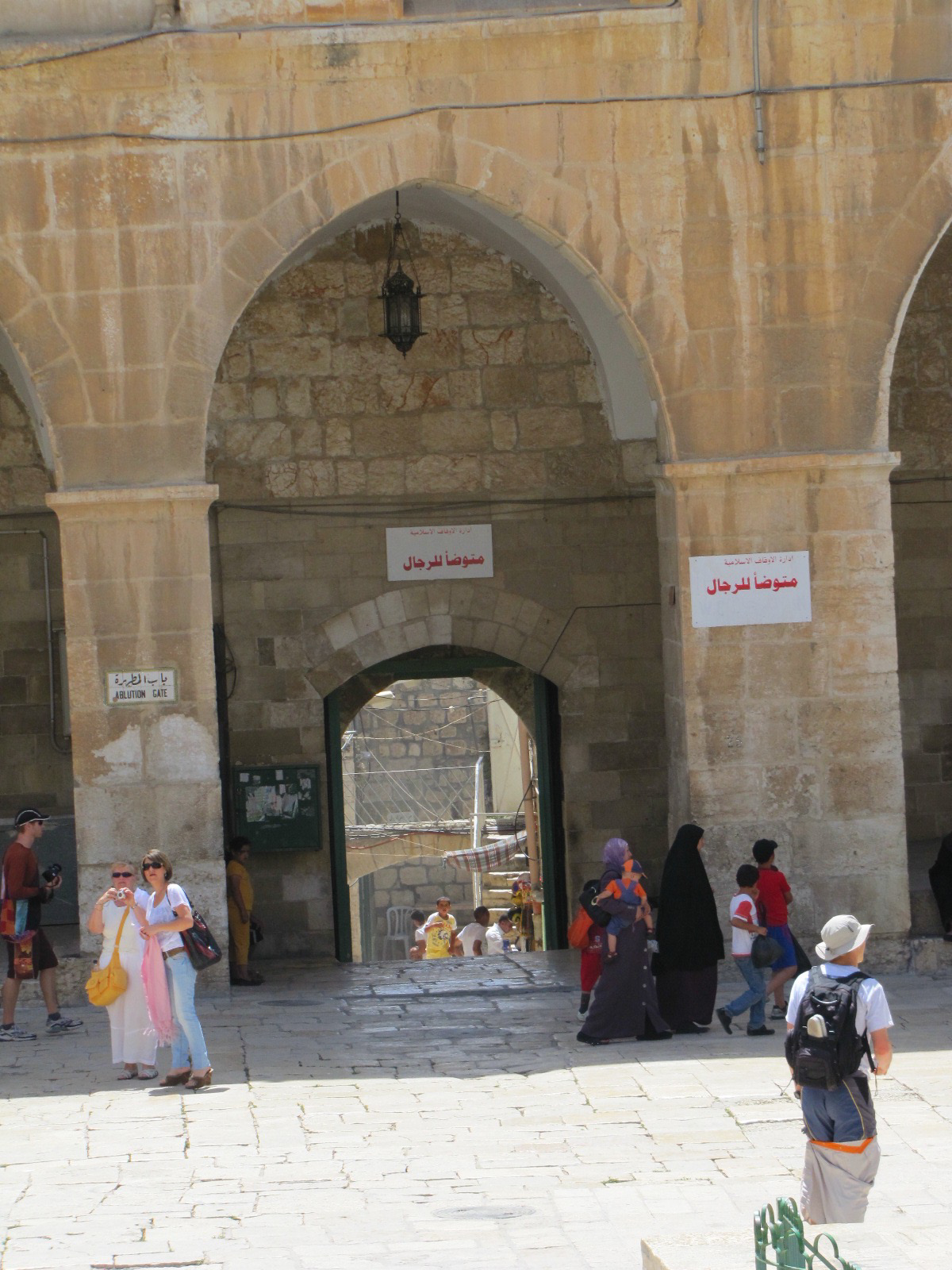
This is the Ablution Gate, or Bab al-Matarah, which is located on the west side of the Temple Mount and leads into the Muslim Quarter of the city. Directly behind me when I took this photo was the stairway seen in the next photo that leads up to the west side of the Dome of the Rock.
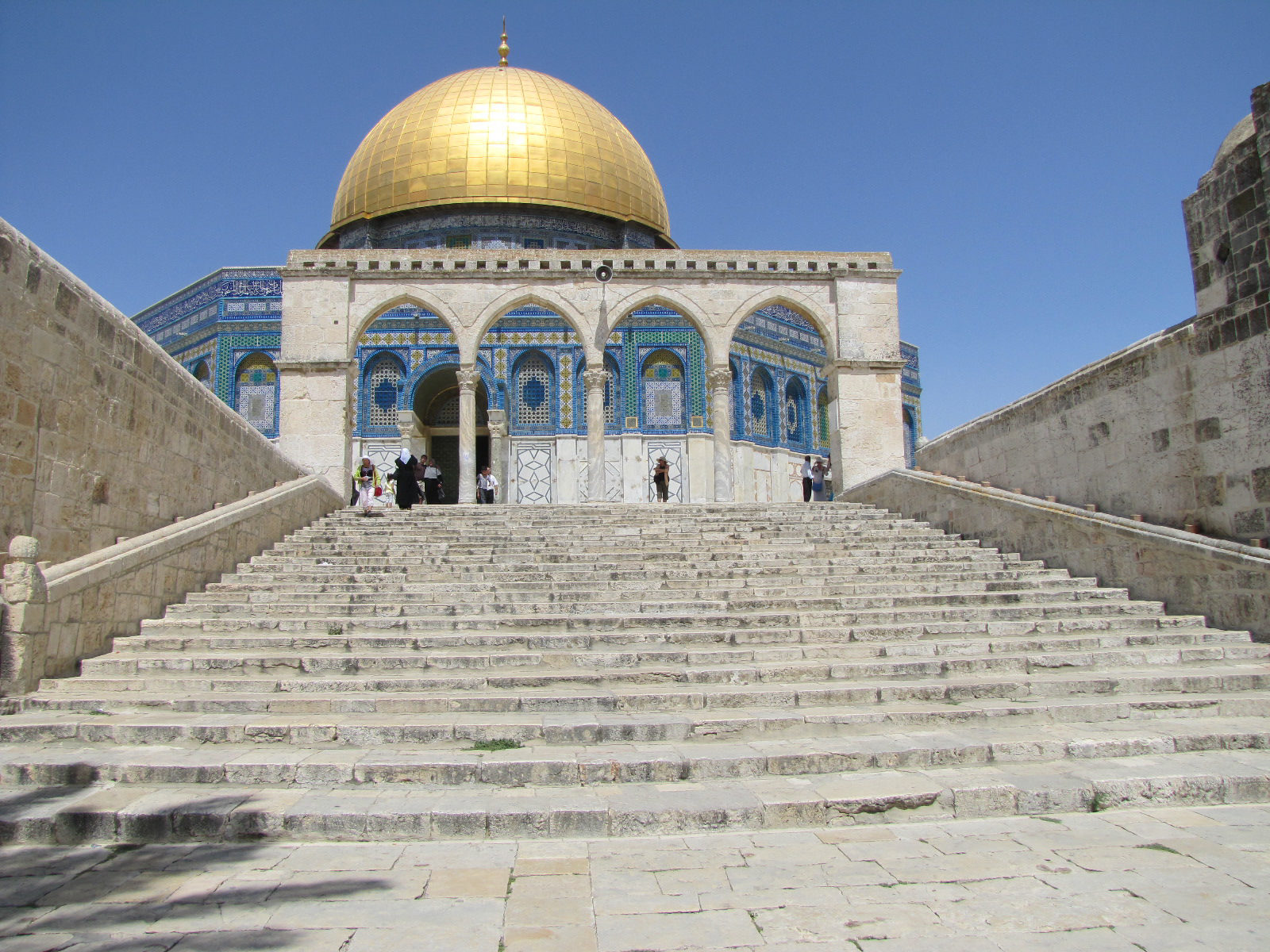
A staircase leading up to the Dome of the Rock from the west side, with the Ablution Gate (Bab al-Matarah) behind.
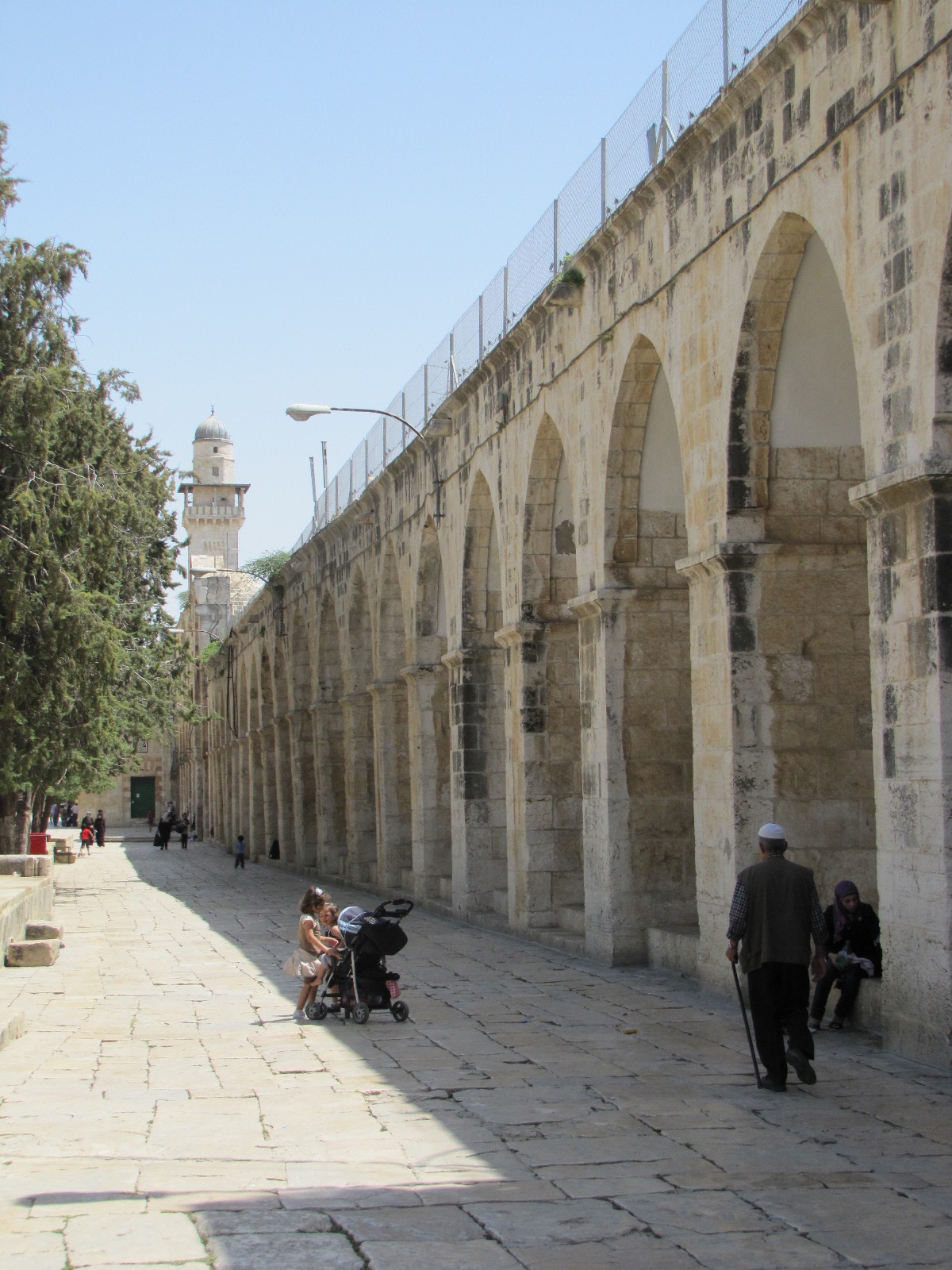
Along the western wall of the Temple Mount on the inside looking south.